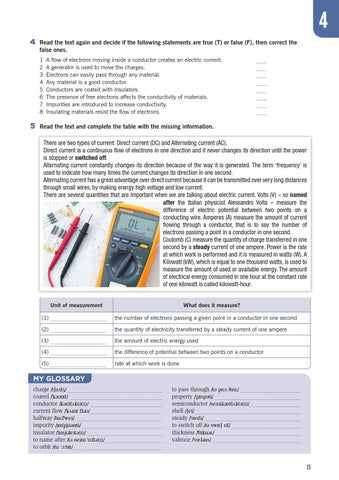4 4 Read the text again and decide if the following statements are true (T) or false (F), then correct the false ones. 1 A flow of electrons moving inside a conductor creates an electric current. 2 A generator is used to move the charges. 3 Electrons can easily pass through any material. 4 Any material is a good conductor. 5 Conductors are coated with insulators. 6 The presence of free electrons affects the conductivity of materials. 7 Impurities are introduced to increase conductivity. 8 Insulating materials resist the flow of electrons.
5
____ ____ ____ ____ ____ ____ ____ ____
Read the text and complete the table with the missing information.
There are two types of current: Direct current (DC) and Alternating current (AC). Direct current is a continuous flow of electrons in one direction and it never changes its direction until the power is stopped or switched off. Alternating current constantly changes its direction because of the way it is generated. The term ‘frequency’ is used to indicate how many times the current changes its direction in one second. Alternating current has a great advantage over direct current because it can be transmitted over very long distances through small wires, by making energy high voltage and low current. There are several quantities that are important when we are talking about electric current. Volts (V) – so named after the Italian physicist Alessandro Volta – measure the difference of electric potential between two points on a conducting wire. Amperes (A) measure the amount of current flowing through a conductor, that is to say the number of electrons passing a point in a conductor in one second. Coulomb (C) measure the quantity of charge transferred in one second by a steady current of one ampere. Power is the rate at which work is performed and it is measured in watts (W). A Kilowatt (kW), which is equal to one thousand watts, is used to measure the amount of used or available energy. The amount of electrical energy consumed in one hour at the constant rate of one kilowatt is called kilowatt-hour. Unit of measurement
What does it measure?
(1) ____________________
the number of electrons passing a given point in a conductor in one second
(2) ____________________
the quantity of electricity transferred by a steady current of one ampere
(3) ____________________
the amount of electric energy used
(4) ____________________
the difference of potential between two points on a conductor
(5) ____________________
rate at which work is done
MY GLOSSARY charge \tSA…dZ\__________________________________ coated \"k´UtId\_ ________________________________ conductor \k´n"døkt´“r‘\__________________________ current flow \"kørnt fl´U\__________________________ halfway \hA…f"weI\_______________________________ impurity \Im"pjU´rIti\_____________________________ insulator \"InsjUleIt´“r‘\___________________________ to name after \t´ neIm "A…ft´“r‘\_____________________ to orbit \tu… "O…bIt\________________________________
to pass through \t´ pA…s Tru…\______________________ property \"prÅp´ti\_______________________________ semiconductor \semik´n"døkt´“r‘\__________________ shell \Sel\______________________________________ steady \"stedi\___________________________________ to switch off \t´ swItS Åf\_________________________ thickness \"TIkn´s\_______________________________ valence \"vœl´ns\________________________________
13
